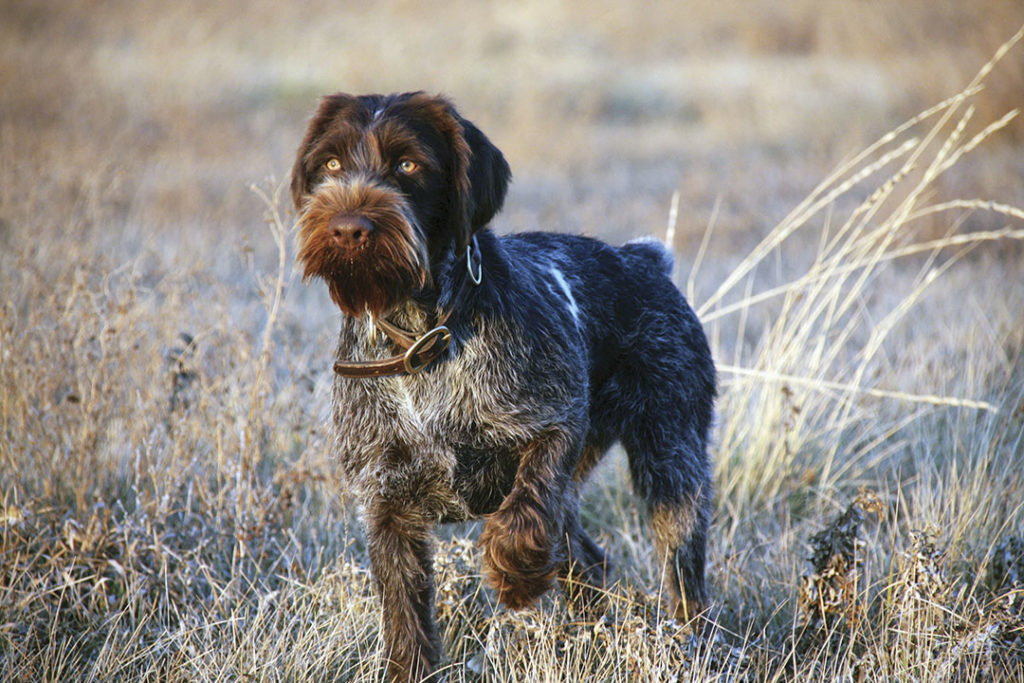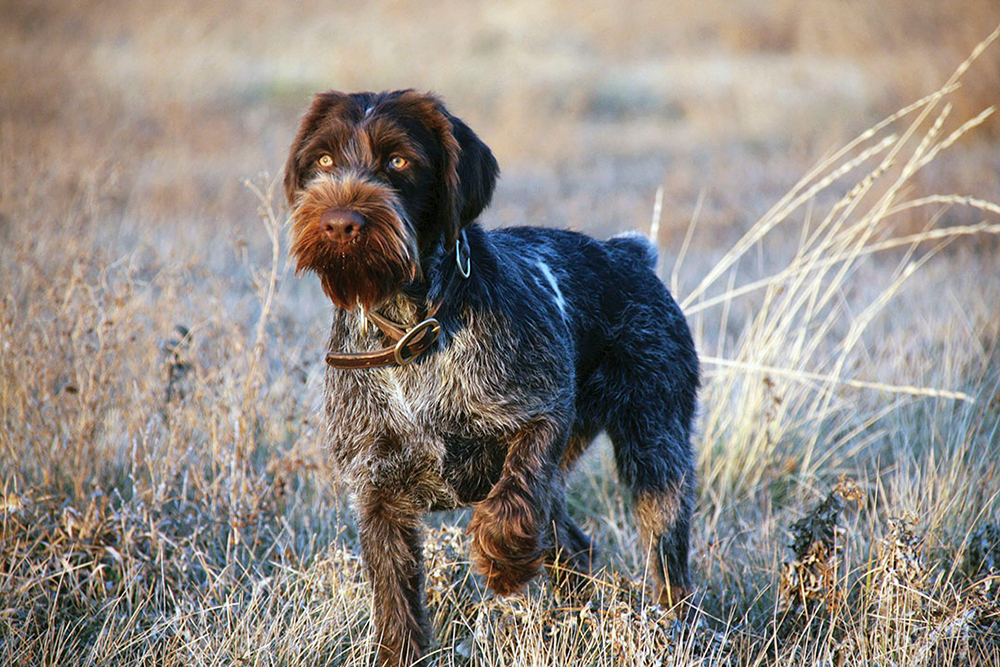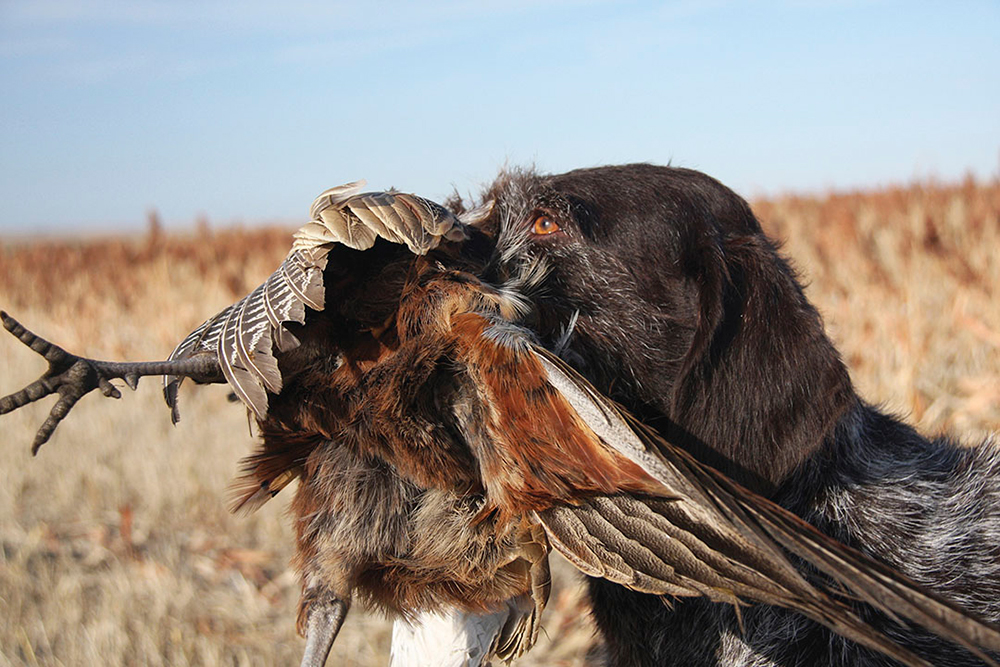BREED PROFILE: THE GERMAN WIREHAIRED POINTER

A quarter-inch of ice lay on the surface of the flooded Arkansas rice field in early January. Tank, a 6-year-old German wirehaired pointer, sat quietly in the blind as we waited for the morning’s first ducks. A heavy overcast made it seem colder than it was. Tank, a solid brown male with a white chest patch and spikey beard, showed his impatience only through the quiver in his knees and an occasional puff of anxious air huffing from his jowls. His pale-yellow eyes stayed fixed on the sky.
Four mallards circled in low toward the decoys. Two of us missed; one connected on the trailing bird. From his perch, Tank could see the body-shot drake sail straight away over the field, dropping in the woods almost 300 yards from the blind. With the “Back!” command barely out of his owner’s mouth, Tank hurled himself from the blind, smashed into the ice-coated water and began chunking his way across. The water was only 18 inches deep – shallow enough so he could push through without swimming – but he had a long way to go. As he did, thin sheets of ice splintered away from his shoulders.
On the other side, Tank’s nose led him to the downed mallard. After grabbing it in his mouth, he took a long look at the water he’d have to cross to get back to the blind. After a pause, and contrary to his direct out-and-back training, Tank ran to the next levee, hopped onto the dike and worked his way overland to deliver the duck. We applauded his smart assessment of the situation. He climbed back onto his perch and stared again at the sky, more than ready for the next retrieve. The hair of his undercoat was dry within minutes.
With a strong water drive and dense coats, German wirehaired pointers are well-suited to waterfowling. Their excellent noses and solid pointing instincts also make them successful upland hunters at an early age. They are athletic dogs with remarkable endurance on land or in water, able to maximize performance while minimizing fatigue. And given the chance, they will happily apply their skills to fur as well as feather.
In many ways, German wirehaired pointers are the canine equivalent of an all-terrain vehicle with state-of-the-art amphibious capability. They are as adept at hauling a 10-pound goose to shore in choppy water as they are holding tight point over a covey of bobwhite quail or cruising the Alaskan tundra in pursuit of ptarmigan.

Stichelhaars and Pudelpointers were fundamental in the development of the German wirehaired pointer, with Griffons and German shorthaired pointers – among several other breeds – crossed in as breeders in the early 20th century enhanced key attributes. The history of the breed is complicated, shaped by the politics of two world wars and by the Continental hunting culture.
The Verein Deutsch Drahthaar is the breed’s parent club in Germany. The VDD has two affiliated clubs – the VDD Group North America and VDD Group Canada. Dogs bred in the VDD system are often called Drahthaars to differentiate them from those bred in the North American Versatile Hunting Dog Association or the American Kennel Club registries. NAVHDA was formed in 1969 as a non-competitive system in which versatile hunting dogs are evaluated in light of North American hunting practices, rather than Continental traditions.
If a German wirehaired pointer is an all-terrain machine, it is run by a robust central computer optimized for the acquisition and delivery of game. Like all versatile dogs, they are expected to find and point birds, track wounded game and retrieve on land or water. They can be intense, yet they display an extraordinary amount of cooperativeness. Most German wirehaired pointers are highly responsive to training. They are rarely “soft” dogs, meaning novice trainers can make mistakes and the dogs will easily recover and relearn.

When Tank locks up on a bird, the point starts at his nose, rippling into stillness after the last shimmy of his cropped tail. Stealthy on ruffed grouse and patient with running pheasants, he is persistent. Unlike the asymmetrical drama of an English pointer’s point, the point of a German wirehaired pointer is a study in strength rather than style.
The color and coat of the German wirehaired pointer vary, with brown roan the most common. The amount of “furniture” – the facial hair – also varies. Some have fuller coats with more wiry coverage; others are tighter and smoother. The benchmark of all well-bred German wirehaired pointers, however, is that the coat is dense, able to shed water, withstand thick brush and provide protection from the cold.
Craig Koshyk, author of the definitive resource book Pointing Dogs (Volume One: The Continentals), says German wirehaired pointers remind him of “the vision and dedication of the German hunters who created the breed. Those men embraced the concept of durch Leistung zum Typ (form follows function), and pushed it further than anyone else to create a breed that is, in many ways, top dog among all the Continental pointing breeds.”
We applauded his smart assessment of the situation. He climbed back onto his perch and stared again at the sky, more than ready for the next retrieve. The hair of his undercoat was dry within minutes.
























